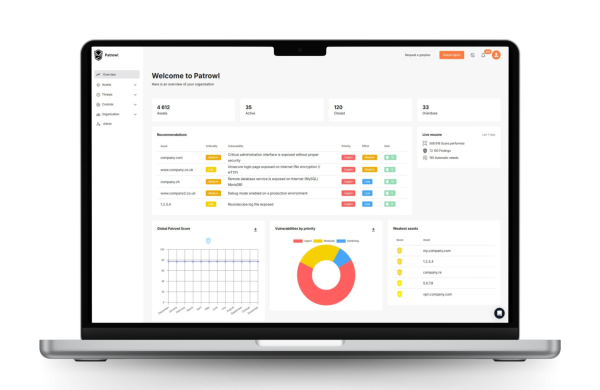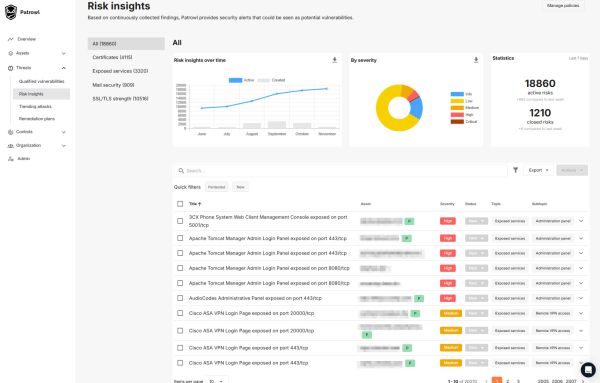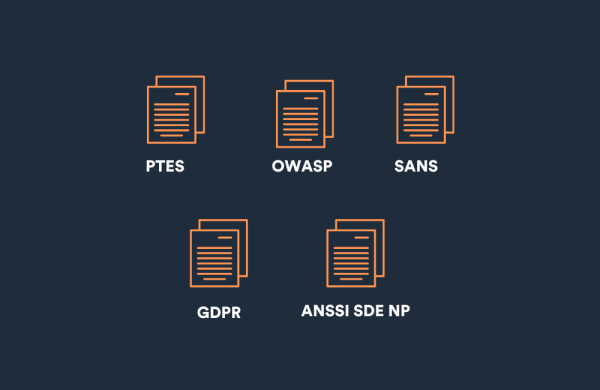Platform
Leader in Offensive Security
Black box penetration testing
Stop wasting time on slow, expensive penetration tests. Patrowl automates security assessments, helping you find and fix vulnerabilities before attackers strike. Automate your time-consuming tasks, regain control, and focus on remediation with our action plans.

What are the advantages of our platform in the penetration testing market?
0 false positive
allowing cybersecurity teams to focus on qualified risks and vulnerabilities.
0 setup
with a fast and simplified deployment in about 30 minutes.
24/7/365
with secure access (encryption and MFA/SSO authentication).
SaaS Solution
with no maintenance or client-side programming required.
100%
customer renewal rate** by 2024.
Awards
Winner of the “Assises de la Cybersécurité” innovation awards (2022/2023)
Definition and objectives of black box penetration testing
Black Box Penetration Testing simulates an attack. In this test, the tester acts like an outside hacker.
They have very little information about the target. Often, they only know the URL or IP address of the system. This method tests your platform's security posture facing external threats without internal assistance.
The main goal of this security assessment is to find weaknesses in a system that is open to the public. An outside attacker could exploit these weaknesses.
This test finds important weaknesses. It shows how an attacker might break into your system. It also helps strengthen your defenses before it's too late.

Methodology and tools used in black box testing
Asset mapping: Patrowl starts by finding exposed assets. It does this by automatically exploring your IP addresses, subdomains, and other external resources. This process helps identify potential attack entry points and common black box vulnerabilities that an attacker may exploit.
Vulnerability identification: Our platform uses both automated tools and manual testing. This helps us find security weaknesses like DNS misconfigurations, SQL injections, and remote code execution flaws.
Exploitation and retesting: If vulnerabilities are detected, Patrowl utilizes automated exploitation techniques to test the potential impact of each flaw. Our experts then conduct manual testing. This helps find more complex vulnerabilities. They also simulate real-world attacks, like brute force attacks and others.

Live attack simulation with Patrowl
80% automated testing, 20% expert verification by certified pentesters.
Patrowl revolutionizes penetration testing by automating the entire process, enabling your teams to focus on fixing vulnerabilities rather than managing complex analyses. Say goodbye to slow and costly manual tests.

PENTEST IS DEAD!


Standards used for our penetration tests and scans
Patrowl follows recognized standards to ensure the quality of its penetration testing. This is based on industry best practices.
PTES: Penetration Testing Execution Standard
OWASP: Web Application Security
SANS: Application and Service Security Auditing
GDPR: General Data Protection Regulation
ANSSI SDE NP: French National Cybersecurity Agency Password Recommendations

Certifications of our experts and pentesters
Patrowl’s pentesters are certified through advanced training programs, ensuring high levels of expertise in your security tests:
SANS GIAC (GPEN, GWAPT, GXPN): Advanced training programs for experts with significant experience.
OSCP: Offensive Security Certified Professional.
SWE Certification: Offensive Security Web Expert.

What vulnerabilities does Patrowl support?
Anything you expose to the internet can become a target for attackers. Patrowl helps you secure all your publicly accessible assets by identifying vulnerabilities before they can be exploited. Our platform supports testing for the following technical assets:
Network & IP-Based Assets: IPv4 address, IPv4 subnet.
Domain and DNS Assets: This includes the domain name, subdomain name, DNS zone, and fully qualified domain name (FQDN). It also covers all types of DNS records, such as MX, SPF, DMARC, and NS.
Web & Application Assets: URL.

Compliance and penetration testing
Ensure regulatory compliance and strengthen cybersecurity.
DORA: Digital resilience for financial sectors (banking, insurance).
NIS 2: Protects critical infrastructures (energy, health, transport).
Cyberscore: Security rating for digital services (websites, social networks).
CaRE Program: Cyber resilience support for SMEs (industry, healthcare).





Protect your systems today to anticipate tomorrow's threats.
Black Box Penetration Testing is essential for protecting your assets against external attacks. With Patrowl, you get a solution that mixes automation and human skills. This helps us do thorough and effective security tests. Don't leave any gaps – secure your systems today.
FAQ
Avantages et limites de l'approche de la boîte noire
Advantages:
Simulates a real-world external attacker.
Helps discover vulnerabilities exposed publicly.
Realistic testing of web applications and infrastructure security.
Limitations:
Black box testing can take a lot of time. It needs a thorough search for flaws. This makes it longer and more costly than other methods.
Some internal vulnerabilities (e.g., configuration errors or architectural issues) can be harder to identify without access to source code.
Use cases and industries that benefit from black box testing
Industries:
E-commerce and Retail: Protect customer data and payment systems from external threats.
Financial Services: Secure banking apps and payment gateways from breaches.
Healthcare: Protect patient data and ensure HIPAA compliance against external threats.
Tech Startups: Ensure newly launched products are secure from the get-go.
Government and Public Sector: Protect sensitive information and critical infrastructure from cyberattacks.
Use cases:
Web Application Security: Testing public-facing websites and applications for vulnerabilities.
API Security: Ensuring that public APIs are secure from unauthorized access and attacks.
Infrastructure Security: Testing exposed network assets, servers, and cloud services for vulnerabilities.
DNS & Domain Protection: Identifying misconfigurations and vulnerabilities in DNS settings and domain names.
Best practices for conducting effective black box penetration tests
Define clear objectives: Understand the scope of the test. Are you testing a web application, an API, or an entire network?
Use multiple tools: Leverage both automated scanning and manual testing to identify a wide range of vulnerabilities.
Simulate realistic attack Scenarios: Think like a hacker. Focus on how an attacker might exploit public-facing systems.
Ensure detailed reporting: Document all vulnerabilities discovered, including the potential impact and remediation advice.
Follow standards: Ensure your test adheres to recognized frameworks like PTES, OWASP, and SANS to ensure completeness.
What is the difference between Black Box and White Box testing?
Black Box Pen Testing means no access to internal systems. It is great for simulating an external hacker. This type of testing has no prior knowledge of the system. It helps to replicate real-world attacks.
White Box Penetration Testing: Full access to internal systems for testing vulnerabilities in source code, architecture, etc.
Grey Box: A combination of both, ideal for simulating insider threats.
At Patrowl, we favor a Black Box approach for most security tests because it mirrors the threats companies face in the real world.
When should a business consider using Black Box Penetration Testing?
To simulate a real attack and test your system's strength against hackers, Black Box Pen Testing is the best option.
What skills are required for conducting Black Box Testing?
Our cybersecurity experts, certified with OSCP, GIAC GPEN, and SANS, ensure thorough and reliable testing.





